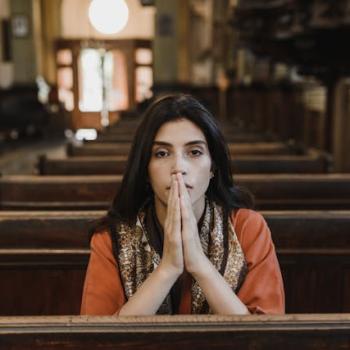Although born into a Catholic family, Matisse had rejected faith as a young man. Like many artists of his generation, he cast himself as an iconoclastic atheist, and initially embraced the “uncivilised” savagery of Fauvism as a means of rejecting the “bourgeois religion” by which he was surrounded. But 1941, at the age of 72, everything changed.
It began with suffering. After being diagnosed with duodenal cancer, he underwent a series of major operations that left him writing in agony. For three months, he was tormented by the pain. As he told Pierre Courthion, he “wondered if it wouldn’t be better to die”. Condemned to endure “a kind of hell”, he was overpowered by bitterness. He lashed out cruelly at his fellow patients and sent visitors packing. But then, a light dawned. As he cried out, one of the nuns in the hospital told him to offer up his pain to God. “All your sufferings will be taken into account up there,” she said, “think of that and you’ll come to love your pain; you’ll see.” Although initially puzzled, he saw the wisdom of her words. He came to believe that he was paying for everything that had gone before. The realisation freed him.
On the day before Palm Sunday, he told Courthion that he had undergone a “rebirth”. Attending Mass for the first time in years, he started to see the world “in a completely different way from before the operation”. He showed a new interest in others, speaking with love and affection to the nuns; and when walking in a nearby park, he compared “a mass of trees in blossom” to the “Virgin’s cloak”. He saw a new beauty in the world.
When Matisse was released from hospital, he returned to the Côte d’Azur with a renewed sense of purpose and excitement. With the help of his Russian assistant, Lydia Delektorskaya, he began his first experiments in “painting with scissors”. But it was Monique Bourgeois, his pious and unassuming young nurse, who gave him direction in his new quest. Armed with her faith, she helped him not only to come to terms with his sufferings, but also to cling to love through the troubles which followed. She consoled him when his daughter was captured by the Gestapo, when bombs fell in his garden and when news came that his student, Rudolf Levy, had died in Auschwitz. She showed that, despite everything, he could make a service of his difficulties through his new art form.
In Jazz (1947), a book of prints accompanied by a commentary, he revealed how his whole attitude towards composition had changed under her tutelage.
Quoting Thomas à Kempis, he explained that it was “love… alone” that had helped him through his sorrows and allowed him to turn “that which is bitter” into the sweetness of the art he created with God’s help. Overcome with a sense of the majesty of grace, he admitted that, far from seeing only the paper and scissors, he now presented himself “with the greatest humility” before his work, “like a communicant approaching the Lord’s Table”.
As he wrote to Monique in a later letter, his art had become an attempt “to make God’s glory visible through purely terrestrial means”. It was a belief to which he gave full expression in his designs for the Chapelle du Rosaire in Vence, where Monique (as Sister Jacques Marie) was cloistered after entering the Dominican order in September 1944. A light and airy chapel, bathed in rich colours and an immense calm, it is a powerful affirmation of love for the divine.














